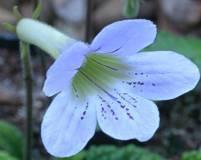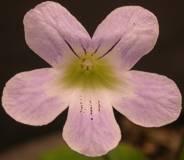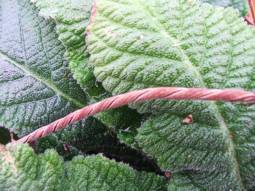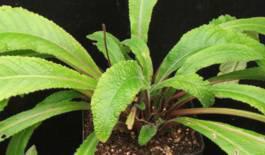Streptocarpus gardenii
Streptocarpus gardenii Hook.
Family: Gesneriaceae
Common names: Cape primrose
Introduction
Streptocarpus gardenii is a delicate, dainty plant with a pale flower that loves the shady gloom found beneath trees.

Description
Description
Streptocarpus gardenii is a herbaceous perennial that grows wider than it is high — 300 x 70 mm, with a shallow root system. Green small strap-like leaves are softly hairy, arranged in a rosette formation, margins scalloped, reddish purple beneath. The inflorescence stalks arise from near the bottom of the midrib of each leaf and flowers of all Streptocarpus have a tiny five-lobed calyx backing a tubular corolla that flares out into a five-lobed mouth. This Streptocarpus flower is usually solitary, sometimes paired, with a narrow greenish-white floral tube and a pale violet lower corolla lip that is streaked with striking deep violet lines, in a broken or unbroken pattern, sometimes even absent.


Flowering occurs from November to April (summer to autumn). Velvety fruit capsules will twist open in a spiral when dry, releasing a large amount of very small, light seeds.
Conservation Status
Status
Many of the Streptocarpus species are very specific in their distribution and occur in very small populations, making them vulnerable to any disturbance. According to IUCN, threat status is Least Concern.
Distribution and habitat
Distribution description
This species is found in Kwazulu-Natal, Eastern Cape and the Free State at altitudes between 900-1950 m. It occurs in forest on mossy rocks, steep slopes and stream banks.
Derivation of name and historical aspects
History
The name Streptocarpus is derived from the Greek words streptos meaning twisted and carpus meaning fruit, which is a perfect description of the plant's spirally twisted seed pods. The specific name was given in honour of Captain R.J. Garden who, in 1853, was attached to the 45th regiment. In that year he was commissioned by the government to explore the country between the Umzimkulu and Giant Castle mountains, and he did a certain amount of collecting.
Cape primroses made their mark in England when they first blossomed at Kew Botanical Gardens in England in 1826, compliments of the collector James Bowie, who took the first plants of Streptocarpus rexii there. As more species were introduced into cultivation in later years, different hybrid Streptocarpus were produced.
Streptocarpus belongs to the same family, Gesneriaceae, as the well-known African violets (Saintpaulia) and gloxinias (Sinningia) that are grown as pot plants all over the world. The Gesneriaceae — named in 1969 after a Swiss scholar, Konrad Gesner, thirty years after his death — is a large family of mostly tropical and subtropical herbs, with ± 139 genera, and ± 2900 species worldwide. Of the 8 genera occurring in Africa, the genus Streptocarpus, which has ± 51 species, is native to southern Africa.
Ecology
Ecology
The shallow root system allows many of the members of the Gesneriaceae to grow successfully as epiphytes, growing on the trunks of trees; or lithophytes, growing in thin layers of moss or humus on rocks; or terrestrially, in the ground soil or in leaf litter on the forest floor. This species is found growing in all three of these situations. The plant can cross-pollinate easily with other species but in many instances are self-pollinated. All the seed pods of this genus have a spiral construction and when the pod dries out the spiral relaxes like a spring, releasing the very small seed to be scattered by the wind.

Uses
Use
Some species of Streptocarpus are used in Zulu medicine where leaf infusions are drunk to ease birthing pains.
Streptocarpus have a lot horticultural potential as indoor and outdoor plants although the trend of most gardeners is to ignore the species and concentrate on the beautiful modern hybrids with their huge trumpet-shaped flowers, often double, in shades of pink, red, blue, lilac, purple, yellow and white. New hybrids are constantly being introduced to the huge and growing pot plant market.
Growing Streptocarpus gardenii
Grow
Streptocarpus gardenii does best as a pot plant rather than planted out in the garden. Ensure a warm spot with good light but no direct sunlight. The plant in general is very sensitive to light and is burned easily by the sun, but flowers poorly in deep shade. Light shade with good ventilation is best for growing healthy plants with plenty of flowers.

Streptocarpus gardenii is a plant that is seldom seen in gardens as it is uncommon in the trade and because it can be difficult to grow in home garden conditions.
Watering Streptocarpus should be done with care. It is very important that the plants should not be over-watered, to avoid rotting and fungal problems. Allow them to get quite dry between watering — they can be allowed to wilt slightly as they have the ability to recover very well from this, but be aware that severe wilting can also be a sign of root rot caused by over-watering, so check the medium to see that this is not the case.
During the warm summers when they are actively growing, they need plenty of water. Most of the Streptocarpus species have a 'rest period' during winter and this slight dormancy will cause them to need very little water during this stage.
Regularly remove all dead, unhealthy, dying leaves and flowers as these encourage fungal growth, and to keep the plants looking attractive. The tips of the leaves often die off as they get older and when stressed by drought or low temperature or when overwintering. This survival tactic does not harm the plants, as although the dead ends may look unattractive, each of the leaves simply forms an abscission layer and continues with new growth from the base. Regular feeding during the growing season with liquid foliar feed is recommended.
Repotting of plants should commence once the roots appear at the bottom of the pot. Remember that with Streptocarpus it is better to under-pot than to over-pot as most of them have shallow root systems and in their natural habitats most often grow in very little soil, if any at all.
Removing spent flowerheads will encourage a longer flowering period as it encourages new flower development.
All propagation is best done in spring which is the start of the growing season. Streptocarpus gardenii can easily be grown from seed. When sowing the seeds, mix a pinch of the dust-like seeds with a small amount of sand to assist with spreading the seeds evenly. Use a well-drained medium that is not too coarse. Cover with a very thin layer of sand, keep out of direct sun but in warmth. Water regularly with a fine spray. Germination usually takes 3-4 weeks, and do not allow the seedlings to dry out. Better germination results are often obtained if the seed tray is covered with a glass sheet or enclosed in a clear plastic packet. Plant the seedlings into small pots only once they are quite big and strong. Transplant again into bigger pots when the roots have filled the small pots.
To get new plants identical to the parents, it is best to propagate from cuttings. Streptocarpus can be propagated from a single leaf and the best results are from leaf cuttings taken in spring and early summer. A variety of mediums can be used as long as they are well drained. Sand, bark, palm fibre and polystyrene or vermiculite in different ratios are all suitable. At Kirstenbosch we use 40 % bark, 40 % polystyrene and 20 % riversand. Water the medium well and treat with a suitable fungicide before using. Select healthy youngish leaves from the centre of the plant and cut off using a sharp knife or blade. Remember that the most active region of the leaf is near the base where the growing region (meristem) is present and so this area will yield the best rooting results. If it is a small leaf, then insert the cut end of the leaf as is into a rooting hormone and then into the medium, larger leaves can be cut into 3 cm strips with each bottom cut end being dipped into rooting hormone.
Always take note of which way the leaf cutting should be orientated before dipping into a rooting hormone and wedge firmly into the medium but not too deep as this will encourage rot. Alternatively, cut along either side of the midrib and treat in the same manner. Plantlets will form along the base of the cut end, in one to three months depending on the species.
When the plantlets are well established, the `old' leaf can be teased out from the medium and the little plantlets gently separated off and then potted up, usually between 6-12 months.
Plants that have grown quite large can also just be divided as a method of increasing them; do this in early spring and repot to grow on. Mature plants can lose their vigour after 3 to 5 years and propagation as described above can be used to replace them with younger plants.
Mealy bug, aphids and caterpillars are the most troublesome pests of Streptocarpus. Caterpillars can either be hand collected or sprayed with a suitable poison; aphids can be sprayed or removed carefully by running a thumb and forefinger along the flower stem, where they usually occur; if mealy bug is found on any part of the plant, quickly remove the affected parts and treat with a suitable pesticide. Kirstenbosch has had great success in managing infestations by using biological control with the natural predators of mealy bug.
Fungal infections are also a cause for concern; if fungus is found on any part of the plant, remove the affected parts and treat with a suitable fungicide
Streptocarpus are usually prone to pests and diseases only when they are not treated or grown correctly — any plant that is stressed is more likely to come under attack. So, to reduce the occurrence of problems, avoid the following: overwatering, underfeeding, root-bound plants, lack of good air movement/circulation.
References
- Arnold, J. 1979. The Illustrated Encyclopedia of House Plants. Ward Lock Ltd, Great London.
- Burtt, B.L. & Hilliard, O.M. 1971. Streptocarpus, an African plant study. University of Natal Press, Pietermaritzburg.
- Davidson, W. 1982. The houseplant survival manual. Hamlyn Publishing Group Ltd, London.
- Goldblatt, P. and Manning, J. 2000. Cape Plants. A conspectus of the Cape Flora of South Africa. Strelitzia 9.
- Leistner, O.A. (ed.). 2000. Seeds plants of southern Africa: families and genera. Strelitzia 10. National Botanical Institute, Pretoria.
- Pearse, R.O. 1978. Mountain Splendour. The wild Flowers of the Drakensberg. Howard Timmins, Cape Town.
- Phillips, R. and Rix, M.1997. Conservatory and Indoor Plants. Plants for Warm Gardens, Vol. 2. Pan Books, London.
- Pooley, E. 1998. A field guide to Wild Flowers of Kwa-Zulu Natal and the Eastern Region. Natal Flora Publications trust, Durban.
- Smith, C.A. 1966. Common names of South African plants. Memoirs of the Botanical Survey of South Africa No. 35.
Credits
Cherise Viljoen
Kirstenbosch National Botanical Garden
March2011
Plant Attributes:
Plant Type: Perennial
SA Distribution: Eastern Cape, Free State, KwaZulu-Natal
Soil type: Loam
Flowering season: Late Summer, Autumn
PH: Neutral
Flower colour: White, Pink, Mauve/Lilac
Aspect: Shade
Gardening skill: Challenging
Special Features:
Horticultural zones







Rate this article
Article well written and informative
Rate this plant
Is this an interesting plant?
Login to add your Comment
Back to topNot registered yet? Click here to register.